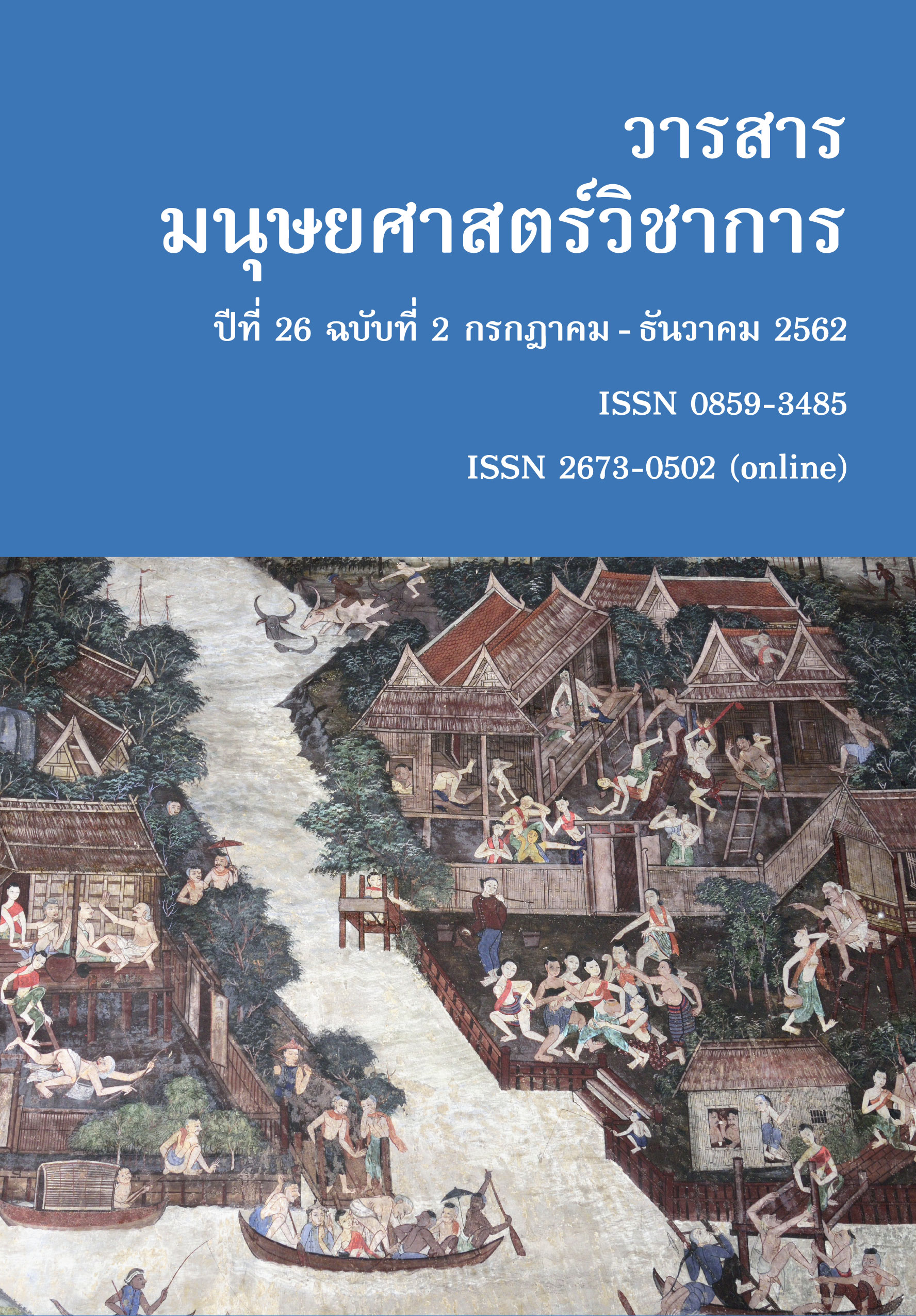ความอุดมสมบูรณ์ สัญคติชุมชนและกระบวนการสร้างรหัสหมายในงานศิลปะร่วมสมัย
Main Article Content
Abstract
This paper is one part of a creative research project, entitled Contemporary Earthenware Pottery, and discusses the subject of fertility. The objective of this study is to generate understanding of systems using symbols to communicate varied concepts of fertility through community art culture. The findings will be used to in creating future contemporary artwork. This study of concepts and symbolism concerning fertility within communities adopted a semiological approach. Semiology is the basis for examining pieces of cultural community art that use systems for creating meanings and codes. The artwork is closely connected to local beliefs and reveals the symbolism of people in the community.
Translation of findings about symbolism in the community informs the process for creating codes and meanings in contemporary art. It also communicates meaning in artwork under the theory of aesthetics (a theory that states meaning is communicated through art). This concept is analysed here as a descriptive analysis. Data were gathered from academic documents and interviews. These sources revealed concepts and perspectives of people regarding the world and beliefs in fertility. Additionally, they disclosed how such beliefs are represented at traditional ceremonies and through symbols in each community. Synthesis and analysis of data were used in the process of creating new artwork which signified “fertility”.
The research results revealed that fertility has been an internationally recognized concept in human communities from ancient times to the present day. It has been used in a variety of creative work, which implies general international characteristics. It is common to find idealistic imagery, such as that in the legend of the Greater Mekong sub-region telling of how humanity was created from a bottle-gourd. This reflects philosophies of life that state “fertility is the origin of life” or “Mother’s uterus is the Creator”. In the Indian Subcontinent, religious principles state that the buranakata (an auspicious and beautifully patterned flower pot representing fertility) has no alternative meanings. For this reason, the researcher took community symbolism to develop contemporary art by using the shape of a bulb to represent the womb or the bottle-gourd shrouding fertile life and ready to blossom. Consequently, the artwork represented the fertility of traditional community knowledge and essential resources that are the foundation of happiness. It is an image that reflects the “fertility of life”.
This study is a research process using the scientific method to draw conclusions from the history of knowledge, the nature of knowledge, the body of knowledge and the creative manifestation of “true beauty”. The results can be used as a method for creating fine art based on research into the academic progress and professionalism of fine arts.
Article Details
References
ติ๊ก แสนบุญ. (ม.ป.ป.). เพศวิถี...เพศสภาพ ในปริมณฑลแห่งศิลปะงานช่างสุวรรณภูมิ. รายงานการวิจัย มหาวิทยาลัยอุบลราชธานี.
ทองแถม นาถจำนง. (2555). ตำนานน้ำเต้าปุง. ทางอีสาน. กรุงเทพฯ: ภาพพิมพ์.
ธนิก เลิศชาญฤทธ์. (2551). คนกับดิน (เผา) ว่าด้วยกำเนิดภาชนะดินเผา. มนุษย์กับภาชนะดินเผาจากอดีตกาลสู่โลกสมัยใหม่. เอกสารวิชาการลำดับที่ 66. กรุงเทพฯ: ศูนย์มานุษยวิทยาสิรินธร (องค์การมหาชน).
ธนิก เลิศชาญฤทธ์. (2560). ภาชนะดินเผายุคก่อนประวัติศาสตร์ในประเทศไทย. นนทบุรี: มิวเซียมเพรส.
ธีรยุทธ บุญมี. (2551). การปฏิวัติสัญศาสตร์ของโซซูร์ เส้นทางสู่โพสต์โมเดอร์นิสม์. กรุงเทพฯ: วิภาษา.
นฤพนธ์ ด้วงวิเศษ. (2555). คำศัพท์ทางมานุษยวิทยา. กรุงเทพฯ: ศูนย์มานุษยวิทยาสิรินธร (องค์การมหาชน) สืบค้นเมื่อ 15 มิถุนายน 2560 จาก https://www.sac.or.th/databases/anthropology-concepts.
ปรานี วงษ์เทศ. (2543). สังคมและวัฒนธรรมในอุษาคเนย์. กรุงเทพฯ: เรือนแก้วการพิมพ์.
พระชาย วรธัมโม. (2556). จิตวิญญาณผู้หญิง ความจริงเหนือศาสนา. คมชัดลึก. กรุงเทพฯ.
มติชนออนไลน์. (2559). เหี้ย เป็นสัตว์ศักดิ์สิทธิ์ กับข้าว ‘เน่าแล้วอร่อย’ วัฒนธรรมร่วมอุษาคเนย์ในอาเซียน [ออนไลน์] สืบค้นเมื่อ 20 มกราคม 2560 จาก http://www.maticho.co.th/prachachuen/news_320152.
เมตตา ศิริสุข. (2557). ศิลปกรรมรูปนาคในภาคตะวันออกเฉียงเหนือ (วิทยานิพนธ์ ดุษฎีบัณฑิต สาขาวิจัยทางศิลปกรรมศาสตร์). มหาวิทยาลัยมหาสารคาม, มหาสารคาม.
สมิต ตะกรุดแก้ว. (2555). คติความเชื่อและสัญลักษณ์ของภาชนะที่ใช้สาหรับการฝังศพนั่ง. วารสารศิลปกรรมศาสตร์ มหาวิทยาลัยขอนแก่น. 1, 1-14.
สันติ สุวิไชย. (2555). การกาเนิดโลกและมนุษย์กับการตีความ “น้าเต้าปุง” ครั้งใหม่. ทางอีสาน. กรุงเทพฯ: ภาพพิมพ์.
สายันต์ ไพรชาญจิตร์. (2551). โบราณคดีเครื่องถ้วยสยาม แหล่งเตาเมืองน่านและพะเยา. นครปฐม: สถาบันวิจัยและพัฒนา มหาวิทยาลัยศิลปากร.
สุจิตต์ วงษ์เทศ. (2547). เรื่องจากปก. ศิลปวัฒนธรรม. 25(3).
สุจิตต์ วงษ์เทศ. (2549). “พลังลาว” ชาวอีสานมาจากไหน?. กรุงเทพฯ: มติชน.
สุจิตต์ วงษ์เทศ. (2551). กบ เรียกฝนบนกลองสัมฤทธิ์ สัตว์ศักดิ์สิทธิ์อุษาคเนย์. สืบค้นเมื่อ 3 ตุลาคม 2560 จาก http://www.sujitwongthes.com/suvarnabhumi/2011.
สุจิตต์ วงษ์เทศ. (2558). คนไทยมาจากไหน. สืบค้นเมื่อ 2 ตุลาคม 2560 จาก http://m.matichon.co.th/readnews.
สุรศักดิ์ แสนโหน่ง และเมตตา ศิริสุข. (2561). ประติมากรรมเครื่องปั้นดินเผาร่วมสมัยจากภูมิปัญญา ช่างท้องถิ่น แนวเรื่องความอุดมสมบูรณ์. รายงานการวิจัย ฉบับสมบูรณ์. กรุงเทพฯ: สำนักคณะกรรมการวิจัยแห่งชาติ.
Rupert Steiner. (2560). Collection Highlights. สืบค้นเมื่อ 2 ตุลาคม 2560 จาก https://www.asianart.com/patan-museum/e16.html.


